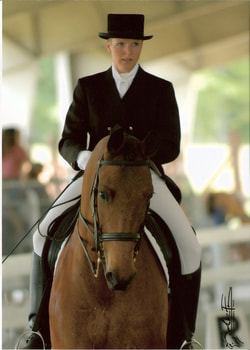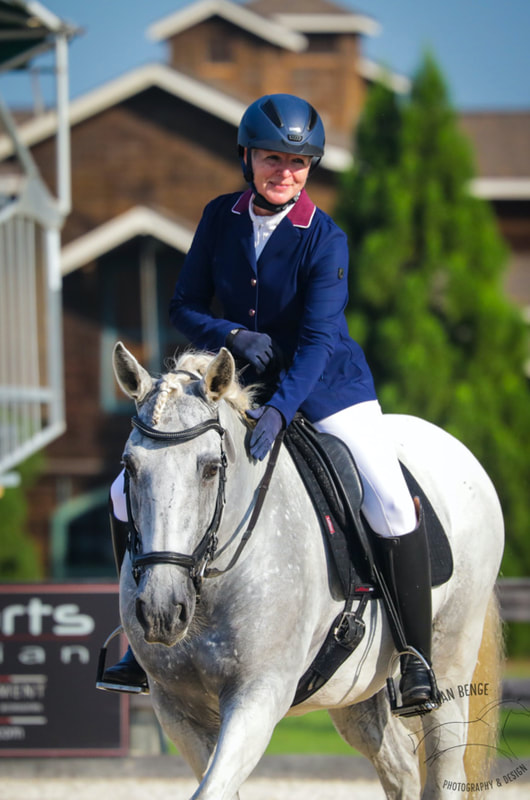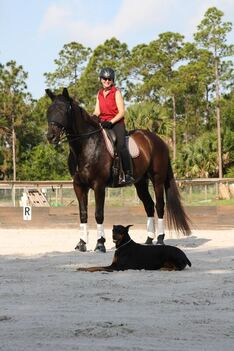Equine system injuries caused by poor saddle fit
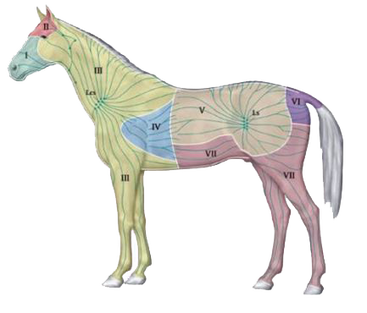
by Miriam Graybeal, csf
November 25, 2016
Conceptually, riders “get it”. Almost every part of the horse's body can be affected by an ill fitting saddle. But do we really take into consideration that damage happens first at a physiological level before we see physical changes? And, do we consider that even slight or mild postural and behavioral changes are a horse’s way of telling us they are compensating to avoid pain and discomfort?
Saddle fit issues can significantly affect a horse's well being on many levels.
Kerry Ridgway, a brilliant whole horse Veterinarian, explained it well when he wrote that bad saddle fit is often the root problem leading to physical and behavioral deficits, pain and unsoundness. He refers to muscles as “the forgotten system in veterinary medicine”, explaining that veterinarians think mostly in terms of tendons, ligaments and joints since those are the areas that require treatment in the end. But these injuries are in fact often the result of muscle stress, pressure and tension absorbed by tendons, ligaments and joints.
Let's explore some of the body systems that can be affected by poor saddle fit and how it can start a chain of events that result in both subclinical and clinical pathology.
The lymphatic and vascular system
The lymphatic system is an extensive network of vessels and lymph nodes that transport lymph or interstitial fluid along pathways paralleling the vascular system. This system allows transport of oxygen and nutrients to travel across vessel walls and membranes to organ and muscle cells and in return, cells get rid of waste products like lactic acid, debris, bacteria and dead cells into the interstitial fluid where it travels back to the lymph nodes to be processed into inactive materials. This is why your lymph nodes are swollen when you are sick.
Consider an ill fitting pad or saddle is that is pinching or causing pressure points. We have all put pressure on an area to control bleeding. Simplistically, pressure points are the same. Over time, with repeated insult, a permanent decrease in overall blood flow in the area occurs. This is called ischemia, which means inadequate blood supply. When organ or muscle cells don’t get nutrition from a healthy blood supply, they lose function, degenerate and die. If the vascular system is not functioning properly, the lymph system is not functioning properly which leads to accumulation of waste products.
The correction is easy. Eliminate the pressure points as soon as you can. Reperfusion of the area will occur and the body will start taking care of itself again. Here is a simplified version of reperfusion physiology in a nutshell: accumulated acidic metabolites and dead cells are flushed into the vascular and lymph system which activates white blood cells and triggers inflammatory reactions, setting histamines free. The downside of reperfusion is that histamines damage the inside cell layers allowing fluid to pass into the cell, causing edema. The good news is that edema is part of the healing process and will resolve if the initial cause has been addressed.
November 25, 2016
Conceptually, riders “get it”. Almost every part of the horse's body can be affected by an ill fitting saddle. But do we really take into consideration that damage happens first at a physiological level before we see physical changes? And, do we consider that even slight or mild postural and behavioral changes are a horse’s way of telling us they are compensating to avoid pain and discomfort?
Saddle fit issues can significantly affect a horse's well being on many levels.
Kerry Ridgway, a brilliant whole horse Veterinarian, explained it well when he wrote that bad saddle fit is often the root problem leading to physical and behavioral deficits, pain and unsoundness. He refers to muscles as “the forgotten system in veterinary medicine”, explaining that veterinarians think mostly in terms of tendons, ligaments and joints since those are the areas that require treatment in the end. But these injuries are in fact often the result of muscle stress, pressure and tension absorbed by tendons, ligaments and joints.
Let's explore some of the body systems that can be affected by poor saddle fit and how it can start a chain of events that result in both subclinical and clinical pathology.
The lymphatic and vascular system
The lymphatic system is an extensive network of vessels and lymph nodes that transport lymph or interstitial fluid along pathways paralleling the vascular system. This system allows transport of oxygen and nutrients to travel across vessel walls and membranes to organ and muscle cells and in return, cells get rid of waste products like lactic acid, debris, bacteria and dead cells into the interstitial fluid where it travels back to the lymph nodes to be processed into inactive materials. This is why your lymph nodes are swollen when you are sick.
Consider an ill fitting pad or saddle is that is pinching or causing pressure points. We have all put pressure on an area to control bleeding. Simplistically, pressure points are the same. Over time, with repeated insult, a permanent decrease in overall blood flow in the area occurs. This is called ischemia, which means inadequate blood supply. When organ or muscle cells don’t get nutrition from a healthy blood supply, they lose function, degenerate and die. If the vascular system is not functioning properly, the lymph system is not functioning properly which leads to accumulation of waste products.
The correction is easy. Eliminate the pressure points as soon as you can. Reperfusion of the area will occur and the body will start taking care of itself again. Here is a simplified version of reperfusion physiology in a nutshell: accumulated acidic metabolites and dead cells are flushed into the vascular and lymph system which activates white blood cells and triggers inflammatory reactions, setting histamines free. The downside of reperfusion is that histamines damage the inside cell layers allowing fluid to pass into the cell, causing edema. The good news is that edema is part of the healing process and will resolve if the initial cause has been addressed.
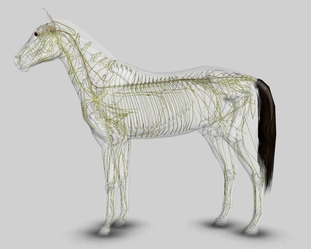
Nerve impingement and dysfunction
When nerves are compressed they do not function properly. I was once told, the weight of a dime for ten seconds causes nerve dysfunction. Imagine what happens for an hour each day with poorly fitting tack.
Meet the Accessory Nerve. A motor nerve that innervates the trapezius, brachiocephalicus and omotransversarius and all the muscles around the withers. When compression occurs in the beginning, discomfort might make a horse unwilling or unable to move forward or move the shoulders in a free manner. Once the nerve is damaged, it inadequately innervates muscle and atrophy of the muscle occurs. Nerves can regenerate slowly, but some chronic nerve damage and muscle atrophy may never recover.
Nerves along the vertebral spinous processes of the withers and back can be affected if a channel is too narrow or the tree is twisting. The same goes for facial nerves if the bridle is not well fitted. A crown can put too much pressure on the poll, cheek pieces can pinch and yes, nose bands can be too tight.
When nerves are compressed they do not function properly. I was once told, the weight of a dime for ten seconds causes nerve dysfunction. Imagine what happens for an hour each day with poorly fitting tack.
Meet the Accessory Nerve. A motor nerve that innervates the trapezius, brachiocephalicus and omotransversarius and all the muscles around the withers. When compression occurs in the beginning, discomfort might make a horse unwilling or unable to move forward or move the shoulders in a free manner. Once the nerve is damaged, it inadequately innervates muscle and atrophy of the muscle occurs. Nerves can regenerate slowly, but some chronic nerve damage and muscle atrophy may never recover.
Nerves along the vertebral spinous processes of the withers and back can be affected if a channel is too narrow or the tree is twisting. The same goes for facial nerves if the bridle is not well fitted. A crown can put too much pressure on the poll, cheek pieces can pinch and yes, nose bands can be too tight.
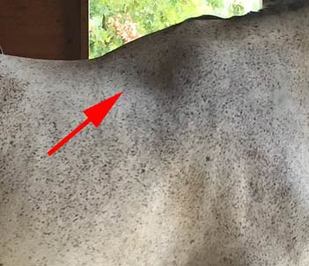
Muscle atrophy
Atrophy of the withers and topline seem to be the first real physical change we can see and quantify. At this point, you know that compression triggers a cascade of physiological responses. Let's review. If you create pressure for long enough, the lymphatic, vascular and nervous system are affected. Compressed nerves poorly innovate muscle and without a functioning nerve supply, the muscle atrophies. It’s true, deep wither pockets on both sides of the withers may be caused by age related changes or conformation, but a five to twelve year old horse should be in the best condition of its life and muscle atrophy is not normal during this stage of life and asymmetrical atrophy is never normal for a horse of any age.
Secondary muscle atrophy can result from postural changes to avoid pain. The horse may change his natural gait to limit using particular muscles. The old saying applies here. If you don’t use it, you lose it.
Atrophy of the withers and topline seem to be the first real physical change we can see and quantify. At this point, you know that compression triggers a cascade of physiological responses. Let's review. If you create pressure for long enough, the lymphatic, vascular and nervous system are affected. Compressed nerves poorly innovate muscle and without a functioning nerve supply, the muscle atrophies. It’s true, deep wither pockets on both sides of the withers may be caused by age related changes or conformation, but a five to twelve year old horse should be in the best condition of its life and muscle atrophy is not normal during this stage of life and asymmetrical atrophy is never normal for a horse of any age.
Secondary muscle atrophy can result from postural changes to avoid pain. The horse may change his natural gait to limit using particular muscles. The old saying applies here. If you don’t use it, you lose it.
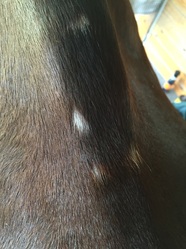
Dermal changes and lesions
Open sores on and around the wither, along the back, girth area and sores where the stirrup bars lay are end stage findings. We can be better horsemen and women than that.
Try looking and feeling for small raised edematous areas along the wither and back that show up after your ride and then disappear fairly quickly, until you ride again. These raised areas will give to your touch and are soft. It’s the fluid in damaged cells, telling you there is a pressure problem.
Girth sores, girth gall or cinch sore. Whatever you call it, the girth does not fit. Sores behind the elbow and triceps are typically caused by friction or from a buckle that is set too low. Some horses have very sensitive skin and just a little rubbing can make a big sore.
Bald spots and loss of pigment (white hairs) can be found anywhere but are most commonly seen on the top or sides of the withers. These can be seasonal and only appear when the coat changes, but are permanent scars of damaged skin.
Nodules are an indication of a much more chronic issue. Found on either side of the withers and along the topline they result from friction and pressure. While they are not usually painful for the horse, nodules develop because tissue has been compromised to the point of deterioration and cell death. The body repairs the area by creating a fibrous scar or nodule.
Open sores on and around the wither, along the back, girth area and sores where the stirrup bars lay are end stage findings. We can be better horsemen and women than that.
Try looking and feeling for small raised edematous areas along the wither and back that show up after your ride and then disappear fairly quickly, until you ride again. These raised areas will give to your touch and are soft. It’s the fluid in damaged cells, telling you there is a pressure problem.
Girth sores, girth gall or cinch sore. Whatever you call it, the girth does not fit. Sores behind the elbow and triceps are typically caused by friction or from a buckle that is set too low. Some horses have very sensitive skin and just a little rubbing can make a big sore.
Bald spots and loss of pigment (white hairs) can be found anywhere but are most commonly seen on the top or sides of the withers. These can be seasonal and only appear when the coat changes, but are permanent scars of damaged skin.
Nodules are an indication of a much more chronic issue. Found on either side of the withers and along the topline they result from friction and pressure. While they are not usually painful for the horse, nodules develop because tissue has been compromised to the point of deterioration and cell death. The body repairs the area by creating a fibrous scar or nodule.
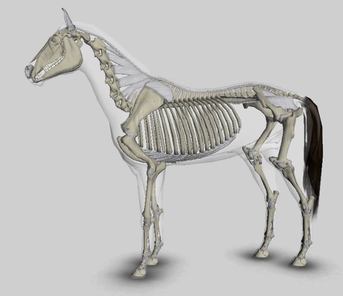
Joint dysfunction & Ligamentous strain or sprain
Did you know that the vertebrae have joints too? They do and they have lots of them! Think of them as small but mighty. Starting at the poll and continuing through the neck, the cervical vertebrae can be described as “locked” when a horse's back is tight or inverted due to postural changes associated with pain. Narrow tree points, rock hard panels or panels with irregular flocking, compressed foam creating pressure points and channels that are too narrow are a few saddle fit problems that cause horses to avoid pressure and change their posture and movement.
Over time, abnormal carriage of vertebrae cause physical changes in the vertebral joints, called spondylosis or osteoarthritis.
When the junction between the last cervical vertebrae and the first few thoracic vertebrae are affected, it can be difficult for a horse to raise his withers and sternum. Think of that the next time you are not getting the “lift” you are asking for. Saddles that create restrictive movement of the shoulder or scapula do not allow full protraction and retraction (range of motion) of the front limbs. Chronic abnormal placement and loading can eventually affect the joints, tendons and ligaments of the front limb. Moving to the mid thoracic area; kissing spines occur when the tips of the dorsal processes make contact with each other. This can be a very painful condition that is exacerbated by poor fitting saddles with narrow channels.
Have you ever considered your saddle may be too short or too long for your horse's back? Have you run your hands or even a brush along his back and in that area well before the roundness of the rump your horse buckles under light touch or pressure? This is the thoracolumbar junction and it seems to be a naturally weak area of the spine, only supported by long narrow muscles. These supportive muscles insert on various points of the pelvis. The lumbosacral area is contained within the confines of the pelvis and is a very complex area of joints and ligaments covered by a thick muscle mass. Pain in this area changes how a horse moves, engages and loads the hind limbs. It is easy to imagine how compensatory mechanisms create opportunity for joint stress and tendon or ligament injury throughout the hindlimb.
Did you know that the vertebrae have joints too? They do and they have lots of them! Think of them as small but mighty. Starting at the poll and continuing through the neck, the cervical vertebrae can be described as “locked” when a horse's back is tight or inverted due to postural changes associated with pain. Narrow tree points, rock hard panels or panels with irregular flocking, compressed foam creating pressure points and channels that are too narrow are a few saddle fit problems that cause horses to avoid pressure and change their posture and movement.
Over time, abnormal carriage of vertebrae cause physical changes in the vertebral joints, called spondylosis or osteoarthritis.
When the junction between the last cervical vertebrae and the first few thoracic vertebrae are affected, it can be difficult for a horse to raise his withers and sternum. Think of that the next time you are not getting the “lift” you are asking for. Saddles that create restrictive movement of the shoulder or scapula do not allow full protraction and retraction (range of motion) of the front limbs. Chronic abnormal placement and loading can eventually affect the joints, tendons and ligaments of the front limb. Moving to the mid thoracic area; kissing spines occur when the tips of the dorsal processes make contact with each other. This can be a very painful condition that is exacerbated by poor fitting saddles with narrow channels.
Have you ever considered your saddle may be too short or too long for your horse's back? Have you run your hands or even a brush along his back and in that area well before the roundness of the rump your horse buckles under light touch or pressure? This is the thoracolumbar junction and it seems to be a naturally weak area of the spine, only supported by long narrow muscles. These supportive muscles insert on various points of the pelvis. The lumbosacral area is contained within the confines of the pelvis and is a very complex area of joints and ligaments covered by a thick muscle mass. Pain in this area changes how a horse moves, engages and loads the hind limbs. It is easy to imagine how compensatory mechanisms create opportunity for joint stress and tendon or ligament injury throughout the hindlimb.
Behavioral responses
Don’t assume it's a bad attitude, breeding or a training issue. Lack of response, over response, aggressiveness, head tossing, tail swishing, bucking and anxiety are ways that horses express discomfort and pain.
Veterinarians, equine massage therapists, bodyworkers, trainers, farriers, owners and saddle fitters should work as a team. Systematically identifying and eliminating causes of pain by treating the equine body as a whole. I have found that qualified saddle fitters who are not partial to one brand over another, but partial to good, fit find it fairly uncomplicated to rule out saddle fit as a cause of inappropriate behavioral responses.
In conclusion, my intention is to educate owners, riders and trainers and to maximize the comfort and performance for both horse and rider. I find it incredible that the physical consequences can be so overwhelmingly problematic from something as easily corrected as saddle fit. We cannot control very many things when it comes to horses, but we can make a difference by ensuring that they are as comfortable as we can make them when we ask them to perform for us.
Miriam is an independent certified fitter who has studied and completed Mike Scott’s School of Saddle Fitting.
Don’t assume it's a bad attitude, breeding or a training issue. Lack of response, over response, aggressiveness, head tossing, tail swishing, bucking and anxiety are ways that horses express discomfort and pain.
Veterinarians, equine massage therapists, bodyworkers, trainers, farriers, owners and saddle fitters should work as a team. Systematically identifying and eliminating causes of pain by treating the equine body as a whole. I have found that qualified saddle fitters who are not partial to one brand over another, but partial to good, fit find it fairly uncomplicated to rule out saddle fit as a cause of inappropriate behavioral responses.
In conclusion, my intention is to educate owners, riders and trainers and to maximize the comfort and performance for both horse and rider. I find it incredible that the physical consequences can be so overwhelmingly problematic from something as easily corrected as saddle fit. We cannot control very many things when it comes to horses, but we can make a difference by ensuring that they are as comfortable as we can make them when we ask them to perform for us.
Miriam is an independent certified fitter who has studied and completed Mike Scott’s School of Saddle Fitting.
I would like to acknowledge, with gratitude, my horses for subtly inspiring me to pay attention, educate myself and be a better horsewoman.
I would like to acknowledge, with gratitude, my horses for subtly inspiring me to pay attention, educate myself and be a better horsewoman.
